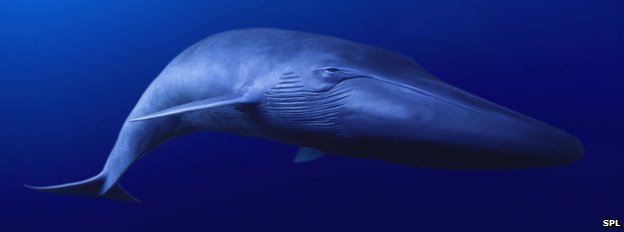News
What’s killing off blue whales? Scientists say their ear wax can tell us

The endangered blue whale species could be saved by its ear wax, according to new research.
Throughout their lives, blue whales accumulate layers of wax in the ear canal that form a plug, almost a foot long, and which remain permanently in place until they die.
Scientists from Texas have analysed these layers, in a manner similar to tree rings, to roughly estimate a specific whale’s age, track changes in its hormone levels, and see which chemicals it was exposed to in the ocean.
This wax can also be used by researchers to work out what needs to be done to protect them from stress, pollution and other threats in the future.
The blue whale is the largest animal on Earth and is listed as ‘endangered’ on the International Union for Conservation of Nature Red List of Threatened Species.
Dr Sascha Usenko from Baylor University made the breakthrough by using the wax from a dead 12-year-old blue whale.
He found fluctuating levels of testosterone and the stress hormone, cortisol, during its life. At the time of its death, Usenko said the whale had twice as much cortisol in its blood than at any other point.
He believes this could relate to food availability, changes in social status, pollution exposure and environmental noise. Testosterone levels suggest the male blue whale reached sexual maturity at about 10 years of age.
‘The general increase in cortisol over the animal’s lifetime could be associated with a multitude of factors including weaning, development, sexual maturity, migration, food availability, environmental conditions, changes in social status, accumulated contaminant exposure or environmental noise,’ said Dr Usenko.
The study also showed the whale had accumulated substantial levels of pollutants – such as pesticides and flame retardants – within its first year of life during gestation or nursing.
In contrast mercury levels in the earplug – which measured around 10 inches – spiked during two distinct time periods later in the animal’s life.
The researchers suggest earplug analysis could help assessments of the impacts of human activities on marine organisms and their ecosystems.
‘Currently obtaining lifetime chemical profiles from birth to death is extremely rare and difficult for most of Earth’s animals,’ said Dr Usenko.
‘We have developed a unique approach to quantify hormone and contaminant lifetime profiles for an individual blue whale using the wax earplug as a natural matrix capable of archiving and preserving these temporal profiles.
‘Using a male blue whale earplug chemical analysis reveals lifetime patterns of mercury and organic pollutant exposure as well as fluctuating hormone levels.
‘We anticipate this technique will fundamentally transform our ability to assess human impact on these environmental sentinels and their ecosystems.
‘The use of a whale earplug to reconstruct lifetime chemical profiles will allow for a more comprehensive examination of stress, development, and contaminant exposure, as well as improve the assessment of contaminant use or emission, environmental noise, ship traffic and climate change on these important marine sentinels.’
Dr Usenko added the 70ft blue whale he studied was hit by a ship off the coast of California in 2007.
Blue whales are the largest mammal to have ever existed on Earth and grow up to 90ft and can weigh 150 tonnes.
They could once be spotted in all major oceans and numbers topped around 200,000, yet after being hunted almost to extinction, there is now thought be as few as 8,000.
The International Whaling Commission has taken steps to protect these creatures by appointing committees of experts to work against whaling, entrapment and predation, but their population remains low.
The findings were reported in the Proceedings of the National Academy of Sciences journal.
Source: Daily Mail
Blogs
Dive into the Full Moon: Experience Palau’s Spectacular Spawning Show

For a truly exceptional diving experience, Liquid Diving Adventures offers a Full Moon Spawning trip from May 20-30, 2025, aboard the Palau Siren liveaboard. This carefully timed journey coincides with the spectacular spawning events of red snappers, creating a breathtaking underwater display that divers won’t want to miss.

During the full moon, red snappers gather in large schools at specific spawning sites, where they release their eggs and sperm in a synchronized event that fills the water with vibrant colors. This incredible spectacle attracts various predators, including sharks and larger fish, which come to feed on the plentiful eggs. Divers have the unique opportunity to witness this dramatic interaction, showcasing the dynamic relationships within the marine ecosystem.

Liquid Diving Adventures curates this experience to provide divers with unparalleled insights into the behavior of red snappers during their spawning ritual. Expert guides share valuable information about the species, their habitat, and the significance of these events to the overall health of the reef ecosystem, enhancing the experience for all participants.

In addition to the thrilling spawning events, some itineraries also offer the chance for blackwater diving. This night-time adventure lets divers explore the ocean’s depths, encountering bioluminescent creatures and other fascinating marine life that thrive in the darkness.

About Palau Siren
The Palau Siren is a 40-meter motorsailor meticulously designed and constructed for divers. Built in Indonesia, this vessel is handcrafted from ironwood and teak to ensure durability and elegance. With a dedicated crew of 12, the ship caters to the needs of up to 16 divers.

Accommodations include eight air-conditioned cabins, each equipped with entertainment systems and ensuite bathrooms. The ship boasts an air-conditioned dining area and lounge that features a cocktail bar, sofas, a flat-screen TV, and a comprehensive entertainment system. To help divers unwind after a day of exploration, daily massage services are available.

Dining is a delightful experience on board, with a covered outdoor dining area where meals are served buffet-style, complemented by an upper-level sun deck furnished with chaise lounges. The covered dive deck is well-equipped with individual gear stations and storage lockers for each diver.

For convenience, all Siren charters provide tanks, weights, BCDs, regulators, wetsuits, masks, and fins at no additional cost, allowing divers to book their trip without the hassle of bringing personal gear. The main lounge features a professional-quality camera and video station for those looking to capture their underwater adventures.

The Palau Siren operates year-round dive trips to Palau, offering complimentary nitrox and supporting rebreathers, though it does not accommodate technical diving. Please note that rebreathers are not available for rent on board.
BOOK IN NOVEMBER AND SAVE $1200 USD!
|
|
News
Scubaverse Acquired by Multiversal Media: A New Era of Expansion into Outdoor Travel and Wildlife Markets

Scubaverse is thrilled to announce its acquisition by Multiversal Media, marking an exciting new chapter in the evolution of the company.
This strategic move aims to fuel further investment and expansion both within niche scuba sectors and into the broader wildlife and outdoor travel markets. The acquisition reflects Multiversal Media’s commitment to enhancing Scubaverse’s capabilities and offerings, ensuring a deeper insight into the diving market while also broadening the scope beyond diving. With increased resources and an expanded team, Scubaverse is poised to delve into diverse travel experiences and outdoor adventures, creating a comprehensive platform for adventure seekers and nature enthusiasts.
“Joining forces with Multiversal Media opens new doors for Scubaverse,” said Dave Alexander, the Founder of Scubaverse. “This partnership not only reinforces our dedication to the diving community, but also empowers us to explore innovative opportunities across the outdoor travel landscape. We are excited about what the future holds and look forward to delivering a richer, more varied experience for our audience.”
Together, Scubaverse and Multiversal Media will focus on integrating advanced insights and strategies to elevate the brand’s presence and offerings. As part of this transition, subscribers and followers can anticipate enhanced content, more extensive travel guides, and exciting collaborations that cater to both diving enthusiasts and outdoor adventurers alike.
About Scubaverse
Scubaverse is a leading media platform for divers from all over the globe, offering insights, news, and resources dedicated to the scuba community. With an unwavering passion for underwater exploration, Scubaverse continues to thrive as a hub for divers worldwide.
About Multiversal Media
Multiversal Media is a dynamic media company focused on creating expansive travel and wildlife content. Committed to showcasing the beauty of nature and the adventure of exploration, Multiversal Media is dedicated to connecting audiences with the outdoor world.
-

 News1 month ago
News1 month agoIconic SS United States to become the World’s Largest Artificial Reef
-

 Blogs3 months ago
Blogs3 months agoNovoScuba’s Game-Changing Approach for Dive Store Owners: WE PAY YOU!
-

 News2 months ago
News2 months agoBook Review – 52 Assignments: Underwater Photography
-

 Gear News2 months ago
Gear News2 months agoDYNAMICNORD – New German diving brand enters the British market
-

 News2 months ago
News2 months agoExploring Cenote El Pit: A Diver’s Dream
-

 Gear News2 months ago
Gear News2 months agoTry BARE drysuits (and maybe even win one!) this Friday with Sea & Sea at North West Dive Fest
-

 News3 months ago
News3 months agoComing Soon – 52 Assignments
-

 Marine Life & Conservation2 months ago
Marine Life & Conservation2 months agoBook Review: Coral Triangle Cameos




